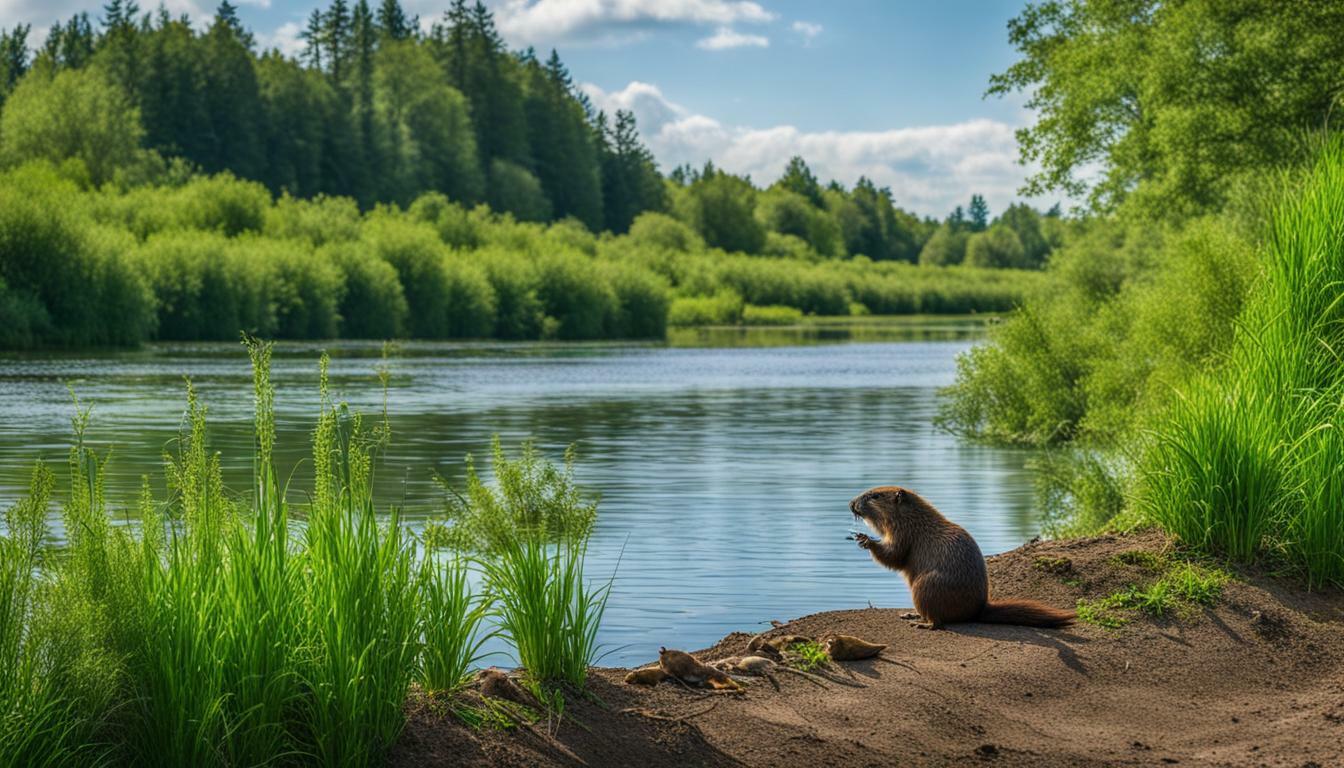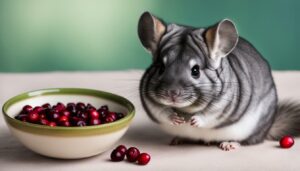If you’ve ever wondered about the presence of beavers in Illinois and the diverse wildlife that call this state home, you’re in the right place.
Yes, there are beavers in Illinois! The American beaver, scientifically known as Castor canadensis, is commonly found statewide in Illinois.
This animal was originally present in Illinois until the late 1800s but was extirpated due to excessive hunting for their pelts.
However, beavers were later restocked in the state, and others moved in from adjacent states to restore populations.
Beavers live in streams, ponds, lakes, ditches, canals, and backwaters, but trees should be present along these waterways for them to reside there.
They primarily eat the bark, twigs, and leaves of trees and shrubs, as well as aquatic plants. Beavers are nocturnal and have an aquatic lifestyle but will come to land to feed, raise their young, or move to a new water body.
They communicate with other beavers by slapping their tail on the water’s surface and can make vocal sounds as well.
Beavers have a unique ability to gnaw through trees using their incisors, and the cut branches and tree parts are taken to their burrows or lodges.
The lodges are dome-shaped structures made of small trees, limbs, and sticks, and can be occupied by several beavers.
Mating occurs in January or February, and the young are born in May or June, usually in litters of three or four. Beavers are considered a common and native species in Illinois.
Key Takeaways:
- Beavers are present in Illinois, specifically the American beaver species.
- They were originally extirpated but were restocked in the state.
- Beavers live in water bodies with trees along the banks.
- They primarily eat bark, twigs, leaves, and aquatic plants.
- Beavers are nocturnal, communicate by slapping their tails, and have unique adaptations for survival.
The American Beaver – Castor canadensis
The American beaver, scientifically known as Castor canadensis, is the species commonly found throughout Illinois. These large, semi-aquatic rodents are an important part of the state’s wildlife population. Historically, beavers were native to Illinois, but due to overhunting for their valuable pelts, their numbers drastically declined. However, through conservation efforts and natural migration from neighboring states, the beaver population in Illinois has been successfully restored.
Beavers thrive in various aquatic environments such as streams, ponds, lakes, ditches, canals, and backwaters. For them to establish a habitat, trees must be present along the waterways. Beavers rely on trees for food and materials to construct their iconic lodges and dams. Their diet mainly consists of bark, twigs, and leaves of trees and shrubs, as well as aquatic plants.
Nocturnal by nature, beavers are primarily active during the night. They communicate with other beavers using various methods, including slapping their flat tails on the water’s surface as a warning signal. Beavers also have the remarkable ability to gnaw through trees using their strong incisors. They use the branches and tree parts they cut to build their lodges, which are dome-shaped structures made of small trees, limbs, and sticks. These lodges can be occupied by multiple beavers, serving as their homes and safe havens.
Beaver mating occurs in January or February, and the young are born in May or June. Typically, beavers give birth to litters of three or four kits. The young beavers stay with their parents for up to two years, during which they learn essential survival skills and contribute to the family’s construction and maintenance of their lodges and dams.
Table: Beaver Facts
| Scientific Name | Common Name | Habitat | Diet | Behavior |
|---|---|---|---|---|
| Castor canadensis | American Beaver | Streams, ponds, lakes, ditches, canals, and backwaters | Bark, twigs, leaves of trees and shrubs, as well as aquatic plants | Nocturnal, communicates through tail slapping, builds lodges and dams |
Historical Presence and Restoration Efforts
Beavers were originally present in Illinois but faced decline due to excessive hunting for their pelts, leading to their extirpation in the late 1800s. However, thanks to conservation efforts, beavers have made a remarkable comeback in the state. To restore their population, beavers were restocked in suitable habitats, and others migrated from nearby states.
Beavers can be found statewide in Illinois, particularly in areas with streams, ponds, lakes, ditches, canals, and backwaters. However, the presence of trees along these waterways is crucial for beavers to build their burrows and lodges. These semiaquatic creatures rely on trees for food, shelter, and building materials.
The diet of beavers consists primarily of the bark, twigs, and leaves of trees and shrubs. They are known for their impressive ability to gnaw through trees using their sharp incisors. The branches and tree parts they cut are then used to construct their lodges. These dome-shaped structures are made from small trees, limbs, and sticks and can be occupied by several beavers.
| Mating Period | Birth Period | Litter Size |
|---|---|---|
| January or February | May or June | Usually 3 or 4 |
Beavers are nocturnal and have a primarily aquatic lifestyle. They communicate with each other by slapping their tail on the water’s surface, creating a loud warning sound. They can also make vocal sounds such as grunts, barks, and screams to convey different messages.
Today, beavers are considered a common and native species in Illinois. They play a vital role in maintaining healthy ecosystems by creating wetlands and providing habitats for a variety of other wildlife species. Efforts continue to protect and conserve these fascinating animals to ensure their long-term survival.
Habitat and Distribution
Beavers can be found in various habitats across Illinois, including streams, ponds, lakes, ditches, canals, and backwaters. These aquatic mammals are highly adaptable and can thrive in both natural and human-altered environments. However, for beavers to reside in an area, trees should be present along the waterways as they play a crucial role in providing the resources necessary for their survival.
The abundance of trees in Illinois makes it an ideal habitat for beavers. They use their sharp incisors to gnaw through trees, creating dams and lodges. These structures serve as their homes and provide protection from predators, as well as a safe place to raise their young. Beavers are skilled engineers, and their dam-building activities help to create wetland habitats that benefit a wide range of wildlife species.
While beavers have a broad distribution throughout Illinois, their presence may vary from region to region. Sightings of these industrious creatures can be more common in areas with ample water bodies and suitable tree cover. As they are primarily nocturnal animals, spotting a beaver during the day can be challenging. However, their presence can often be detected by the signs they leave behind, such as chewed trees, dams, and lodges.
| Common Habitat Types | Potential Sightings |
|---|---|
| Streams | Chewed trees along the banks |
| Ponds | Beaver dams and lodges |
| Lakes | Chewed trees near the shoreline |
| Ditches | Signs of dam-building activities |
| Canals | Beaver lodges |
| Backwaters | Chewed vegetation and floating debris |
Overall, beavers are considered a common and native species in Illinois. Their presence not only contributes to the state’s rich wildlife diversity but also plays a crucial role in maintaining healthy aquatic ecosystems.
Diet and Behavior
Beavers primarily feed on the bark, twigs, and leaves of trees and shrubs, as well as aquatic plants, and they are active mainly during the night. These herbivorous creatures have an incredibly efficient digestive system that allows them to extract nutrients from the tough cellulose found in plant materials. Their diet consists mainly of the inner bark of trees, especially those with softer wood, such as aspen, willow, and cottonwood. They will also consume the leaves and twigs of various shrubs and aquatic plants.
Beavers are well adapted for their semi-aquatic lifestyle. They possess webbed hind feet, which enable them to swim swiftly in water. They can hold their breath underwater for up to 15 minutes, which facilitates their ability to dive and forage for food. Beavers also have a thick layer of fat beneath their skin, providing insulation and buoyancy as they navigate through their watery habitats. It’s fascinating to observe them skillfully maneuvering logs and branches as they build dams and lodges, showcasing their impressive strength and agility.
In terms of communication, beavers have an array of signals to convey messages to each other. They use different vocalizations, such as grunts and whines, to communicate various emotions and intentions. However, their most distinctive form of communication is the tail slap. When a beaver slaps its large, flat tail on the water’s surface, it creates a loud noise that can be heard from a considerable distance. This serves as a warning sign to other beavers in the vicinity, alerting them to potential danger or intrusions into their territory.
Adaptations for Survival
Beavers have several remarkable adaptations that allow them to thrive in their unique environment. One of their most notable adaptations is their ability to gnaw through trees using their powerful incisors. Their incisors are continuously growing, and constant gnawing helps keep them sharp and prevent overgrowth. This adaptation allows beavers to fell trees and create the necessary materials to construct their dams and lodges.
The lodges built by beavers are architectural marvels, constructed using a combination of mud, sticks, and logs. These structures provide shelter and protection from predators, as well as a safe place for raising their young. The interior of the lodge consists of dry chambers where the beavers can live comfortably. The entrances to the lodge are located underwater, providing additional security.
Table 1: Beaver Adaptations
| Adaptation | Description |
|---|---|
| Webbed Hind Feet | Facilitates efficient swimming and maneuvering in water. |
| Thick Insulating Fur | Protects against cold temperatures and water. |
| Powerful Incisors | Enables gnawing through trees and building structures. |
| Ability to Hold Breath | Allows for extended underwater foraging. |
Overall, beavers are fascinating creatures with unique behaviors and adaptations. Their presence in Illinois is not only a testament to the state’s diverse wildlife but also a reminder of the importance of conservation efforts to protect these remarkable animals and their habitats.
Communication and Adaptations
Beavers communicate using tail slaps on the water’s surface and can produce vocal sounds to interact with other beavers. These tail slaps serve as a warning signal to alert other beavers of potential danger or to communicate territorial boundaries. The loud impact of their tail hitting the water creates a distinctive noise that can be heard from a distance, allowing beavers to effectively communicate in their aquatic environment.
Aside from tail slaps, beavers also use a variety of vocalizations to express different messages. These vocal sounds range from low growls and grunts to high-pitched whines and squeals. By combining these vocalizations with their body language, beavers can convey information related to mating, social status, and potential threats.
In addition to their communication methods, beavers have unique adaptations that enable them to thrive in their environment. One of their most notable adaptations is their incisors, which are specially designed for gnawing through trees. These sharp teeth grow continuously throughout their lives, allowing them to efficiently fell trees and construct dams and lodges. The felled trees are then used to create their homes, which provide shelter and protection from predators.
Adaptation and Behavior Table
| Adaptation | Explanation |
|---|---|
| Webbed Feet | Beavers have webbed hind feet, which aid in swimming and diving. The webbing allows them to navigate through water with ease, making them highly efficient in their aquatic lifestyle. |
| Transparent Eyelids | Beavers have transparent eyelids that act like goggles, allowing them to see underwater without hindrance. This adaptation enables them to search for food and build their structures with precision. |
| Dense Fur and Oily Coat | Beavers possess dense fur and sebaceous glands that produce oil. This combination keeps their fur waterproof, providing excellent insulation and protection from the cold water they inhabit. |
| Valve-Like Nose and Ears | Beavers have special nose and ear adaptations that can close off to prevent water from entering. This allows them to swim and dive without discomfort or risk of water inhalation. |
| Large, Flat Tail | Beavers have a large, flat tail, which serves multiple purposes. It acts as a rudder while swimming, helps with balance on land, and assists in communication through the distinctive tail slaps. |
These adaptations, combined with their effective communication methods, have contributed to the beavers’ successful survival and conservation efforts in Illinois. With ongoing conservation initiatives and the presence of suitable habitats, beavers continue to play an essential role in the state’s wildlife ecosystem.
Building Dams and Lodges
Beavers construct dams and lodges using small trees, limbs, and sticks, creating dome-shaped structures that can house multiple individuals. These impressive architectural feats serve both practical and social purposes for beaver communities in Illinois. The dams they build help create and maintain aquatic habitats by slowing down the flow of water, which allows for the formation of ponds and wetlands. These areas provide ample food sources and protection from predators. Additionally, the lodges serve as shelter for the beavers, providing a safe space to rest, raise their young, and store food.
The construction of dams and lodges involves a meticulous process executed by the beavers with great precision. They use their powerful incisors to gnaw away at trees, cutting them into manageable lengths for transportation. The cut branches and tree parts are then skillfully woven together with mud and stones to create the foundation of the dam or lodge. The beavers continue to add layers of sticks, debris, and mud, reinforcing the structure and ensuring its stability.
Inside the lodge, the beavers create comfortable chambers lined with soft materials such as grass, leaves, and shredded bark. These chambers provide separate spaces for eating, sleeping, and nursing the young. The dome-shaped design of the lodge is not only aesthetically pleasing but also helps regulate temperature and protect the beavers from extreme weather conditions. The entrance to the lodge is underwater, providing a hidden and secure passage for the beavers to enter and exit their dwelling.
| Dams and Lodges | Key Features |
|---|---|
| Construction Materials | Small trees, limbs, sticks, mud, stones |
| Dome Shape | Regulates temperature, protects from weather |
| Interior Chambers | Separate spaces for eating, sleeping, and nursing young |
| Underwater Entrance | Hidden and secure passage for entry and exit |
| Function | Create habitats, provide shelter, store food |
The ability of beavers to build such intricate structures showcases their remarkable adaptability and resourcefulness. Through their dam-building activities, beavers play a vital role in the ecosystem, influencing the hydrology of their surroundings and creating diverse habitats that support a wide range of plant and animal species.
Reproduction and Family Structure
Beavers mate in January or February, and their young are typically born in May or June, often in litters of three or four. Mating between beavers is a remarkable process that involves intricate behaviors and communication.
When it’s time to find a mate, beavers engage in a series of vocalizations and scents to attract each other. The male and female then form a strong bond and remain monogamous throughout their lives. Once a pair has established a bond, they will work together to build a nest, also known as a lodge, where their offspring will be born and raised.
Inside the lodge, the female beaver will create a birthing chamber using soft materials such as grass, leaves, and bark. This chamber provides a comfortable and safe space for the newborn kits. After a gestation period of approximately three months, the female gives birth to her young. The kits are born fully furred and with their eyes open, ready to explore their new surroundings.
| Beaver Facts | Information |
|---|---|
| Gestation Period | Approximately 3 months |
| Litter Size | Typically 3-4 kits |
| Parental Care | Both parents participate in raising the kits |
Both parents take an active role in caring for their young. The kits are nursed by their mother and quickly learn how to swim and forage for food. As the kits grow, they will gradually be introduced to solid food, starting with small bits of vegetation and eventually transitioning to a diet similar to that of adult beavers.
Interesting Facts about Beaver Families:
- Beaver families are known as colonies and are typically comprised of the parents and their offspring from previous years.
- The young beavers stay with their parents for about two years before venturing out to start their own families.
- It is not uncommon for multiple generations of beavers to share a lodge, with each family having their own individual living space.
- Beavers have a strong sense of family and are highly social animals. They rely on each other for protection, food gathering, and survival.
Understanding the reproductive and family structure of beavers is essential for their conservation and management. By protecting their habitats and ensuring sustainable populations, we can continue to enjoy the presence of these incredible animals in Illinois for generations to come.
Current Status and Conservation Efforts
Beavers are considered a common and native species in Illinois, and conservation efforts aim to protect and sustain their populations. The presence of beavers in the state is indicative of healthy aquatic ecosystems and serves as an important indicator of environmental quality.
To ensure the conservation of beavers in Illinois, various initiatives have been put in place. These efforts focus on habitat restoration, population monitoring, and public education about the significance of beavers in maintaining biodiversity and ecological balance.
One key conservation strategy is the creation of beaver management plans that promote sustainable coexistence between humans and beavers. These plans involve implementing non-lethal methods, such as flow devices and beaver deceivers, to manage the impacts of beavers on human infrastructure while allowing them to continue their natural behaviors.
| Conservation Efforts | Description |
|---|---|
| Habitat Restoration | Efforts are made to restore riparian vegetation, which provides crucial habitat for beavers. This includes planting native trees and shrubs along waterways. |
| Population Monitoring | Regular surveys and assessments are conducted to monitor beaver populations and track their distribution across the state. This data helps inform conservation strategies. |
| Public Education | Public outreach programs and educational campaigns are conducted to raise awareness about the ecological importance of beavers and the need to coexist with them. |
By implementing these conservation efforts, Illinois aims to preserve the natural heritage of beavers and ensure the long-term survival of this iconic species. The continued presence of beavers in the state not only contributes to the overall biodiversity but also enhances the health and resilience of freshwater ecosystems.
Other Wildlife in Illinois
While beavers are a fascinating part of Illinois’ wildlife, the state is also home to a wide range of other animals, adding to its rich biodiversity. Whether you’re an avid nature enthusiast or simply enjoy observing wildlife, Illinois has much to offer in terms of its diverse fauna.
One notable animal species found in Illinois is the white-tailed deer (Odocoileus virginianus), which is commonly spotted throughout the state. These graceful creatures can often be seen grazing in open fields or wooded areas, and they have become a symbol of the state’s natural beauty.
In addition to deer, Illinois is also home to a variety of bird species, both resident and migratory. From the majestic bald eagle to the vibrant and melodious songbirds, birdwatchers can enjoy spotting a wide array of species in different habitats across the state.
Table 1: Common Wildlife Species in Illinois
| Common Name | Scientific Name | Habitat |
|---|---|---|
| White-tailed Deer | Odocoileus virginianus | Wooded areas, open fields |
| Bald Eagle | Haliaeetus leucocephalus | Rivers, lakes, wetlands |
| Eastern Chipmunk | Tamias striatus | Wooded areas, gardens |
| Red Fox | Vulpes vulpes | Forests, grasslands |
| Great Blue Heron | Ardea herodias | Wetlands, marshes |
Illinois also boasts a diverse mix of mammals, such as the eastern chipmunk (Tamias striatus) and the red fox (Vulpes vulpes), which can be found in various habitats including forests and grasslands. These mammals contribute to the ecological balance of the state and provide opportunities for nature enthusiasts to observe and learn about their unique behaviors and adaptations.
Whether you’re interested in mammals, birds, or other wildlife, Illinois offers ample opportunities for exploration and appreciation of its natural wonders. From the beavers that shape its waterways to the myriad of other animals that call it home, the state’s wildlife is a testament to the resilience and beauty of nature.
Conclusion
In conclusion, beavers are indeed present in Illinois, with the American beaver species thriving in various habitats across the state. These fascinating creatures, scientifically known as Castor canadensis, were originally found statewide but were extirpated in the late 1800s due to excessive hunting for their pelts. However, through restocking efforts and natural migration from neighboring states, the beaver population has been successfully restored in Illinois.
Beavers can be found in a variety of water bodies, including streams, ponds, lakes, ditches, canals, and backwaters. However, they require the presence of trees along these waterways to build their lodges and burrows. These industrious animals primarily feed on the bark, twigs, and leaves of trees and shrubs, as well as aquatic plants.
Beavers are nocturnal and have an aquatic lifestyle. They communicate with each other by slapping their tails on the water’s surface and can also make vocal sounds. Their unique adaptation of gnawing through trees using their incisors allows them to create lodges and dams. The lodges are dome-shaped structures made of small trees, limbs, and sticks, and can be occupied by several beavers.
Mating typically occurs in January or February, with the young being born in May or June. Beavers usually have litters of three or four offspring. Today, beavers are considered a common and native species in Illinois, thanks to conservation efforts and a growing awareness of their importance in maintaining healthy ecosystems.
FAQ
Are there beavers in Illinois?
Yes, there are beavers in Illinois. The American beaver, scientifically known as Castor canadensis, is commonly found statewide in Illinois.
What caused the decline of beavers in Illinois?
Beavers were extirpated from Illinois in the late 1800s due to excessive hunting for their pelts.
How were beavers restocked in Illinois?
Beavers were later restocked in the state, and others moved in from adjacent states to restore populations.
Where do beavers live in Illinois?
Beavers live in streams, ponds, lakes, ditches, canals, and backwaters. Trees should be present along these waterways for them to reside there.
What do beavers eat in Illinois?
Beavers primarily eat the bark, twigs, and leaves of trees and shrubs, as well as aquatic plants.
Are beavers nocturnal?
Yes, beavers are nocturnal and have an aquatic lifestyle, but they will come to land to feed, raise their young, or move to a new water body.
How do beavers communicate?
Beavers communicate with other beavers by slapping their tail on the water’s surface. They can also make vocal sounds.
How do beavers build their lodges?
Beavers have a unique ability to gnaw through trees using their incisors. The cut branches and tree parts are taken to their burrows or lodges. The lodges are dome-shaped structures made of small trees, limbs, and sticks, and can be occupied by several beavers.
When do beavers mate and give birth in Illinois?
Mating occurs in January or February, and the young are born in May or June, usually in litters of three or four.
Are beavers considered a common species in Illinois?
Yes, beavers are considered a common and native species in Illinois.
Source Links
- https://dnr.illinois.gov/content/dam/soi/en/web/dnr/education/cdindex/americanbeaver.pdf
- https://www.chicagotribune.com/news/environment/ct-chicago-beavers-pandemic-20201229-apggz4txevcqdfesaeg4i643qe-story.html
- https://dnr.illinois.gov/content/dam/soi/en/web/dnr/education/cdindex/americanbeaverapdf.pdf




